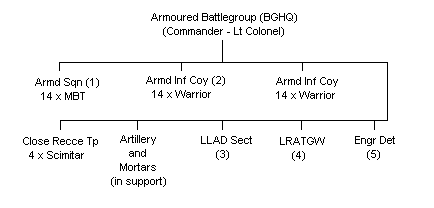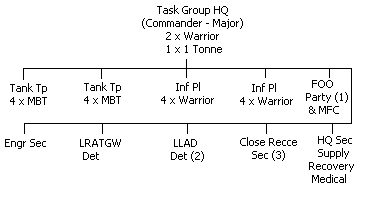|
A
Division usually consists of two or three Brigades. These Brigades are further
sub-divided into smaller formations known as Battlegroups. The
Battlegroup
is the basic building brick of the fighting formations.
A Battlegroup is commanded by a Lieutenant
Colonel and the Infantry Battalion or Armoured Regiment that he commands
provides the command and staff element of the formation. The Battlegroup
is then structured according to task, with the correct mix of infantry,
armour and supporting arms.
The Battlegroup
organisation is very flexible and the units assigned can be quickly
regrouped to cope with a change in the threat. A typical Battlegroup
fighting a defensive battle on the FEBA (Forward Edge of the Battle
Area), and based upon an organisation of one armoured squadron and two
mechanised companies, could contain about 600 men, 16 tanks and about 80
armoured personnel carriers.
The number of Battlegroups in a division and a brigade could vary
according to the task the formation has been given. As a general rule
you could expect a division to have as many as 12 Battlegroups and a
brigade to have up to three or four. The following diagram shows a
possible organisation for an Armoured Battlegroup in either 1(UK)
Armoured Division or 3(UK) Division.

|
(1) Armoured Squadron
(2)
Armoured Company (in a Mechanised Company the vehicles will be
Saxon)
(3)
LLAD - Low-Level Air Defence - HVM
(4) LRATGW - Long-Range Anti-Tank
Guided Weapon
(5) Engineer Detachment
|
COMPANY GROUP/TASK
GROUP
Each Battlegroup will operate
with smaller organisations called task groups or company
groups. These groups which are commanded by a Major, will be allocated
tanks, armoured personnel carriers and supporting elements depending upon
the aim of the formation.
Supporting elements such as air defence, anti-tank missiles, fire
support and engineer expertise ensure that the combat team is a
balanced all arms grouping, tailored specifically for the task. In
general a Battlegroup similar to the one in the previous diagram could
be expected to form three company groups.
Expect a Group organisation to
resemble the following diagram:

|
Notes:
(1) Forward Observation
Officer (FOO - usually a Captain) with his party
from the Royal Artillery. This FOO will be in direct communication with a
battery of six/eight guns and the Artillery Fire Direction Centre. The MFC
(Mortar Fire Controller) is
usually a sergeant from an infantry battalion mortar platoon who may have
up to six mortar tubes on call. In most Combat Teams both the FOO and MFC
will travel in close proximity to the Combat Team Commander
(2) Possibly 2 x Spartan with HVM
(3) Possibly 2 x Scimitar
|
|